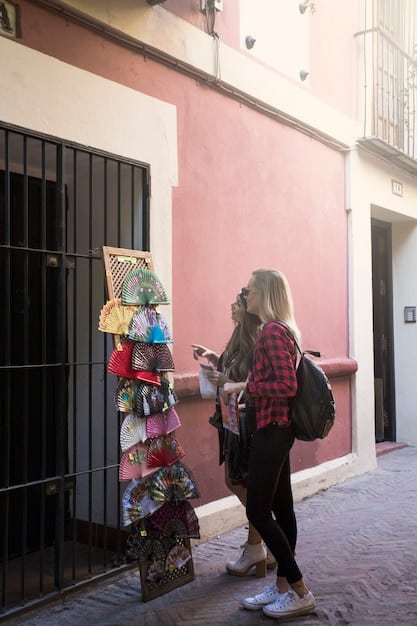Mexico’s Real Estate Market: Is Now a Good Time for US Investors to Buy?

The current landscape for US investors in the Mexican real estate market presents a nuanced picture of both significant opportunities and distinct challenges, requiring thorough due diligence and an understanding of evolving economic and political factors before making acquisition decisions.
The allure of sunny beaches, vibrant culture, and competitive pricing has long drawn American buyers south of the border. Yet, for those considering a significant investment, a critical question emerges: Mexico’s Real Estate Market: Is Now a Good Time for US Investors to Buy? This query transcends simple economics, delving into a complex interplay of geopolitical shifts, local market dynamics, and personal investment goals that demand careful consideration.
understanding the currents: mexico’s economic stability and growth
Before diving into specific property types or regions, understanding the broader economic landscape of Mexico is paramount. The country’s economy, while diverse, is heavily influenced by its northern neighbor, the United States. This symbiotic relationship can be a double-edged sword, offering stability through trade agreements like the USMCA (United States-Mexico-Canada Agreement) but also exposing Mexico to US economic volatility.
Recent years have showcased Mexico’s resilience, even amidst global economic turbulence. A growing middle class, coupled with government initiatives aimed at infrastructure development and fostering foreign investment, has contributed to a more robust economic foundation. This evolving stability directly impacts real estate valuations, providing both upward potential and a degree of predictability for long-term investors.
inflation and interest rates: what to watch
Like any market, Mexico’s real estate sector is sensitive to macroeconomic factors. Inflation, while somewhat higher than in the US, has been a key focus of the Banco de México, which has taken measures to stabilize prices. Understanding these trends is crucial as they influence property values, rental yields, and the cost of financing. Changes in interest rates, both in Mexico and globally, can significantly affect borrowing costs for US investors, making due diligence on financing options a necessity.
- Mexican inflation rates and their impact on purchasing power.
- Interest rate differentials between Mexico and the US, and how they affect loans.
- Government fiscal policies and their influence on economic stability.
Furthermore, the diversification of Mexico’s economy beyond oil and tourism, towards sectors like manufacturing, technology, and agriculture, provides a broader base for sustained growth. This structural shift can create new employment opportunities, leading to increased demand for housing and commercial properties in emerging urban centers. For investors, identifying these growth hubs early could unlock significant long-term value.
In essence, Mexico’s economic trajectory presents a compelling narrative of a developing nation solidifying its position on the global stage. While challenges remain, the foundational elements for a growing and increasingly stable market are evident, offering a promising outlook for those willing to engage with its nuances.
where to look: hot spots and hidden gems for us investors
The vastness and diversity of Mexico mean that “the Mexican real estate market” is not a monolithic entity. Different regions offer distinct advantages and investment profiles, catering to various investor types. For US investors, popular choices often include coastal resort towns, vibrant colonial cities, and increasingly, emerging urban centers near industrial hubs.
Coastal areas like the Riviera Maya (Cancun, Playa del Carmen, Tulum) and Baja California Sur (Cabo San Lucas, La Paz) remain perennial favorites. Their established tourism industries, direct flights from the US, and perceived lifestyle benefits attract a steady stream of buyers looking for vacation homes, retirement properties, or rental income generators. These markets tend to be more mature, with higher price points but also greater liquidity and established rental markets.
colonial charm vs. urban dynamism
Beyond the beaches, cities like San Miguel de Allende, Oaxaca, and Mérida offer a rich cultural experience and often more affordable pricing, particularly for those seeking a more authentic immersion into Mexican life. These “pueblos mágicos” and historic cities appeal to retirees, artists, and digital nomads. Rental income potential exists, often from long-term stays or cultural tourism.
- Riviera Maya: high demand, established infrastructure, potential for strong rental yields.
- Baja California Sur: luxury market, high-end tourism, strong appreciation in specific niches.
- San Miguel de Allende: cultural hub, expat community, stable appreciation.
- Mérida and Oaxaca: authentic experiences, lower cost of living, growing popularity.
However, an often-overlooked opportunity lies in Mexico’s burgeoning industrial and logistical centers. Cities like Monterrey, Querétaro, and Guadalajara are experiencing rapid growth fueled by foreign direct investment in manufacturing and technology. While perhaps lacking the immediate visual appeal of a beach resort, these areas offer robust opportunities for commercial real estate, industrial parks, and affordable residential options catering to a growing workforce.
Diversification across these varied markets could be a prudent strategy. An investor might balance a higher-yield, higher-risk tourism property with a more stable, albeit slower-appreciating, residential unit in a growing urban center. Understanding local zoning laws, population growth projections, and infrastructure development plans in each specific area is key to making an informed decision. The “best” location is ultimately subjective, aligning with an investor’s personal goals and risk tolerance.

legalities and logistics: navigating the buying process as a us citizen
For US investors, the process of buying property in Mexico comes with specific legal and logistical considerations that differ significantly from those in the United States. While the overall framework is straightforward, understanding these nuances is critical to ensure a secure and legal transaction. The most common concern relates to foreign ownership, particularly in restricted zones.
Mexican law restricts foreign ownership of land within 100 kilometers (approximately 62 miles) of a national border and 50 kilometers (approximately 31 miles) of the coastline. This “restricted zone” encompasses many of the most desirable tourist destinations. However, this doesn’t preclude foreign ownership; instead, it mandates a specific legal structure: the “fideicomiso,” or bank trust.
the fideicomiso: your gateway to coastal and border properties
A fideicomiso is not a lease; it’s a trust agreement where a Mexican bank holds the legal title to the property on behalf of the foreign beneficiary (the buyer). The foreign buyer holds all the rights of ownership, including the right to use, sell, mortgage, or inherit the property. The trust is initially established for a 50-year term and is renewable indefinitely. This structure has been in place for decades and is a secure, well-established legal mechanism. Key aspects of the fideicomiso include:
- The bank acts as a trustee, not the owner.
- The foreign beneficiary retains full control and economic benefits.
- Allows ownership in otherwise restricted zones.
- Renewable every 50 years, making it a long-term solution.
Beyond the fideicomiso, other legal considerations include title searches, ensuring the property is free of liens or encumbrances, and understanding local property taxes and closing costs. It is essential to work with a reputable, independent real estate attorney in Mexico who specializes in foreign ownership. They can conduct due diligence, guide you through the process, and ensure all documents are properly executed and registered. Relying solely on the seller’s agent or attorney is not advisable, as their interests may not fully align with yours.
Additionally, investors should be aware of the foreign exchange implications. Real estate transactions in Mexico are typically conducted in Mexican Pesos (MXN), even if prices are quoted in US Dollars. Fluctuations in the USD-MXN exchange rate can impact the final cost of the property and future rental income. Establishing a local bank account or using international wire transfers are common practices, and understanding the associated fees and exchange rates is important for cost management.
Navigating these legal and logistical aspects successfully requires patience, professional guidance, and a thorough understanding of the process. While it may seem daunting at first, the well-established framework for foreign ownership, combined with experienced legal professionals, makes it a manageable and secure undertaking for those looking to invest in Mexico.
financing your investment: options and considerations
Securing financing for a real estate investment in Mexico as a US citizen can present some unique challenges and opportunities. While not as straightforward as obtaining a mortgage in the United States, several avenues exist, each with its own set of requirements and implications. Understanding these options is crucial for planning your investment strategy.
Historically, securing a traditional mortgage from a Mexican bank has been complex for foreign nationals due to varying requirements and lending practices. However, this landscape is evolving. Some large Mexican banks and specialized lenders are now offering mortgage products tailored for foreigners, often requiring a higher down payment (typically 20-30%) and potentially higher interest rates compared to US mortgages.
us-based financing and alternative strategies
An alternative often explored by US investors is to secure financing within the United States, such as a home equity loan or line of credit on an existing US property, or a personal loan. This approach can simplify the financing aspect by separating it from the Mexican transaction, offering potentially lower interest rates and more familiar lending terms. However, it requires having sufficient equity or collateral in the US. Another common strategy is cash purchases, particularly for smaller properties or those seeking to avoid financing complexities. This can also provide a stronger negotiating position with sellers.
- Mexican mortgages for foreigners: higher down payments, specific lending criteria.
- US home equity loans/lines of credit: leverages US assets, potentially lower rates.
- Personal loans: faster, but often higher interest rates and shorter terms.
- Cash purchases: simplifies process, stronger negotiation, but ties up capital.
Beyond traditional loans, builder financing is sometimes available, particularly for new developments. Developers may offer direct financing options, often with flexible payment schedules during the construction phase. While convenient, it’s critical to meticulously review the terms, interest rates, and the developer’s reputation before committing. Private lenders and investment groups also operate in Mexico, offering more flexible but often higher-cost financing solutions.
Regardless of the financing method, understanding the full cost of ownership is paramount. This includes not only the purchase price but also closing costs (which can be substantial, often 4-7% of the purchase price), property taxes, HOA fees, maintenance, and potential rental management fees. Exchange rate fluctuations can also impact loan repayments if financing is in one currency and income in another. A comprehensive financial plan, considering all these variables, is essential for a successful and sustainable real estate investment in Mexico.
understanding risks and challenges for us investors
While the Mexican real estate market offers undeniable appeal, a balanced perspective requires a candid look at the potential risks and challenges that US investors might encounter. Acknowledging and preparing for these can significantly mitigate their impact and contribute to a more secure investment journey.
One primary concern relates to legal complexities and bureaucratic hurdles. While the fideicomiso provides a secure legal framework for foreign ownership, navigating Mexico’s legal system can be slow and opaque for those unfamiliar with it. Property disputes, inheritance issues, and difficulties with local permits or regulations can arise. This underscores the critical importance of working with reputable, independent, and experienced Mexican legal counsel throughout the entire process.
political and economic volatility
Mexico, like any emerging market, can be subject to periods of political and economic volatility. Shifts in government policy, changes in trade relations (particularly with the US), and unforeseen economic downturns can impact market stability. While Mexico has shown resilience, investors should be aware that the market may not always follow a linear growth trajectory. Currency fluctuations, specifically the USD-MXN exchange rate, can also affect the value of an investment when converted back to US dollars, impacting both purchase cost and potential returns.
- Legal and bureaucratic hurdles: slow processes, need for expert local legal advice.
- Political uncertainty: policy shifts, government changes, potential impact on foreign investment regulations.
- Economic volatility: inflation, exchange rate fluctuations, global economic slowdowns.
- Security concerns: while localized, specific regions may present higher risks.
Security is another concern that often weighs on the minds of potential investors. While many tourist areas and expat communities are largely safe, incidences of crime and cartel activity in certain regions can affect perceptions and, in extreme cases, real estate values. Researching specific locations and understanding local safety dynamics is prudent. Generally, areas with established tourism infrastructure tend to have higher levels of security and dedicated tourist police.
Finally, the practical challenges of managing an overseas property, especially if you do not reside in Mexico full-time, should not be underestimated. This includes property management, maintenance, finding reliable tenants (if renting), and dealing with local utilities and services. Engaging a trustworthy local property manager or agency can alleviate many of these burdens, but it adds to the overall operational costs. Thorough due diligence, realistic expectations, and a well-informed approach to these potential challenges are key to a successful Mexican real estate venture.
return on investment: short-term gains vs. long-term appreciation
When evaluating “Is now a good time to buy?”, the potential for return on investment (ROI) is a primary driver for many US investors. However, ROI in the Mexican real estate market can manifest in different forms: immediate rental income (short-term gains) and long-term capital appreciation. A clear understanding of your investment goals will dictate the best strategy and property type.
For investors focused on short-term gains, properties in highly sought-after tourist destinations often offer strong rental income potential. Vacation rentals, capitalizing on the booming tourism sector, can provide consistent cash flow, especially in peak seasons. However, this strategy comes with its own set of considerations, including: seasonality, competition from other rental properties, the need for effective marketing, and potentially higher wear and tear on the property. Engaging a professional property management company is almost essential for this model, which will reduce your net rental income but alleviate operational burdens.
capital appreciation and market trends
Long-term appreciation, on the other hand, relies on broader market trends, economic growth, and regional development. Properties in areas experiencing significant infrastructure investment, population growth, or the establishment of new industries often demonstrate steady capital appreciation over several years. This includes not only popular tourist hubs but also emerging urban centers and areas poised for industrial expansion. The key here is patience and a keen eye for underlying growth drivers rather than immediate cash flow.
- Short-term rental income: high potential in tourist areas, but subject to seasonality and management costs.
- Long-term capital appreciation: linked to economic growth, infrastructure, and population trends.
- Diversification: combining rental income properties with long-term holds.
- Market fundamentals: employment rates, tourism growth, foreign direct investment.
A balanced strategy might involve a combination of both. An investor could target a property that offers reasonable rental income to offset carrying costs, while also being situated in an area with strong potential for long-term value growth. This hybrid approach can provide both immediate returns and future wealth building.
Forecasting ROI requires careful due diligence, including researching historical appreciation rates for specific regions and property types, understanding local rental market demand, and analyzing all associated costs (purchase, ongoing ownership, and potential sale expenses). While past performance is no guarantee of future returns, a diligent study of these factors will provide a more realistic projection of your potential gains in Mexico’s dynamic real estate landscape.
final verdict: so, is now a good time to buy?
After navigating the intricacies of Mexico’s economic landscape, geographical hotspots, legal frameworks, financing options, and inherent risks, we return to the central question: Is now a good time for US investors to buy in Mexico’s real estate market? The answer, as is often the case with complex investment decisions, is nuanced and depends heavily on individual circumstances and objectives.
For the informed, patient, and strategically minded investor, Mexico continues to present compelling opportunities. The country’s strong tourism sector, growing economy, lower cost of living, and proximity to the US remain powerful draws. The legal framework for foreign ownership, while requiring specific procedures like the fideicomiso, is well-established and secure. Furthermore, the diverse real estate offerings—from beachfront luxury to cultural retreats and industrial hubs—cater to a wide spectrum of investment goals.
considerations for the discerning investor
However, it is equally clear that this is not an investment for the ill-prepared. Success in the Mexican real estate market hinges on meticulous due diligence, a willingness to navigate unfamiliar legal and financial systems, and a pragmatic understanding of potential risks. Engaging independent local experts – real estate agents, attorneys, and property managers – is not merely advisable; it is essential. They provide the local knowledge and expertise necessary to mitigate common pitfalls and ensure a smooth transaction.
- Defined Goals: Clearly articulate your investment objectives (e.g., rental income, capital appreciation, personal use).
- Thorough Research: Investigate specific regions, local market trends, and historical performance.
- Expert Guidance: Hire independent Mexican real estate attorneys and agents.
- Risk Awareness: Understand and plan for legal, economic, political, and operational challenges.
- Long-Term Vision: mexico is generally a market for long-term investment rather than quick flips.
In essence, “now” can be a good time if you approach the Mexican real estate market with a well-researched strategy, a robust financial plan, and a network of trusted local professionals. It is less about timing the market perfectly and more about making an informed decision that aligns with your personal risk tolerance and investment horizons. For those willing to do their homework and engage thoughtfully, Mexico’s real estate market holds considerable promise.

| Key Point | Brief Description |
|---|---|
| 📈 Market Growth | Mexico’s economy is diversifying, supporting real estate growth beyond tourism. |
| ⚖️ Legal Framework | Fideicomiso (bank trust) secures foreign ownership in restricted zones. |
| 📍 Hotspot Diversity | Coastal resorts, colonial cities, and industrial hubs offer varied opportunities. |
| ⚠️ Key Challenges | Requires due diligence, expert legal advice, and awareness of market risks. |
frequently asked questions
▼
Yes, a US citizen can own property in Mexico. However, a specific legal mechanism called a “fideicomiso” (bank trust) is required for properties located within the restricted zones (100km from borders or 50km from coasts). Outside these zones, direct ownership is generally possible.
▼
Beyond the purchase price, buyers should budget for closing costs, which typically range from 4% to 7% of the property value. These costs include transfer taxes, notary fees, legal fees, appraisal fees, and the cost of establishing the fideicomiso, if applicable. Property taxes are generally lower than in the US.
▼
Security concerns are often localized, and many popular expat and tourist areas are generally safe for residents and investors. Due diligence on specific locations is crucial. Working with reputable real estate professionals and a local attorney helps mitigate risks and ensures secure, legal transactions.
▼
The fideicomiso is a trust where a Mexican bank holds legal title to the property for the foreign buyer’s benefit. The buyer retains all rights of ownership, including use, sale, and inheritance. It is a secure, well-established legal structure, renewable every 50 years, and widely used for foreign property ownership in Mexico.
▼
Popular regions include coastal areas like Riviera Maya (Cancun, Playa del Carmen, Tulum) and Baja California Sur (Cabo San Lucas) for tourism and rental income. Colonial cities like San Miguel de Allende and Mérida attract retirees and cultural enthusiasts. Emerging urban centers like Monterrey and Guadalajara also offer investment potential.
conclusion
In summation, the decision for US investors to enter Mexico’s real estate market now is not a simple yes or no, but rather a strategic calculation. While the allure of attractive pricing, favorable exchange rates, and a vibrant culture persists, successful investment hinges on a thorough understanding of the unique legal, economic, and practical considerations involved. With diligent research, expert local counsel, and a clear vision for your investment goals, Mexico can indeed offer a rewarding opportunity for wealth building and a desirable lifestyle. Navigating its complexities with an informed approach is the ultimate key to unlocking its potential.





